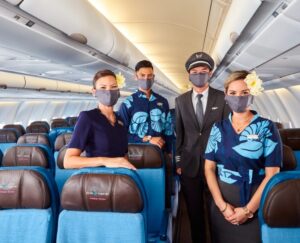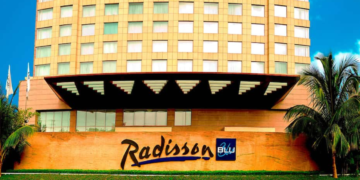Passengers aboard a Hawaiian Airlines flight are reportedly planning to file a lawsuit against the carrier after a bout of severe turbulence left dozens of people injured. The incident occurred on Flight HA23 from Honolulu to New York JFK on Thursday.
According to reports, the Boeing 767-300ER encountered severe turbulence around three hours into the flight, causing the aircraft to jolt violently. Several passengers were thrown from their seats, and some even hit the ceiling, resulting in a range of injuries, including cuts, bruises, and broken bones.
The airline said in a statement that 40 passengers and crew members were treated for injuries upon arrival in New York. However, some passengers claim that the crew didn’t respond quickly enough, leaving them without medical assistance for several minutes.

A spokesperson for Hawaiian Airlines said the airline is aware of the incident and is conducting an internal investigation. The airline has offered to pay for medical bills and hotel accommodation for affected passengers.
The incident comes just weeks after another Hawaiian Airlines flight from Honolulu to Seattle encountered severe turbulence, injuring 10 people.
Passengers affected by the latest incident are reportedly planning to file a lawsuit against the airline, claiming negligence and seeking compensation for their injuries.
According to aviation safety experts, turbulence is a common occurrence in commercial aviation and is usually harmless. However, severe turbulence can be dangerous and cause injuries, which is why airlines are required to take steps to prevent and mitigate the effects of turbulence.
Passengers can reduce their risk of injury during turbulence by wearing a seatbelt at all times when seated. In cases of severe turbulence, the airline crew will instruct passengers to fasten their seatbelts and remain seated until it is safe to move around the cabin.
In situations where passengers have been injured due to turbulence, it is important to seek medical attention as soon as possible. Passengers should also report the incident to the airline and keep records of their injuries and medical treatment. This information can be used to support a claim for compensation.
The aviation industry has a duty of care to ensure the safety of passengers and crew members. In cases where airlines are found to be negligent or in breach of their duty of care, passengers may be entitled to compensation for their injuries.

It remains to be seen whether the passengers who were injured during the Hawaiian Airlines flight will be successful in their lawsuit against the carrier. However, this incident serves as a reminder of the importance of airline safety and the duty of care owed to passengers.
To mitigate the risks associated with turbulence, airlines are required to have procedures in place to monitor and predict weather conditions that could lead to turbulence. This information is used to plan flight routes and adjust altitudes to avoid areas of turbulence wherever possible.
In addition, airlines must ensure that their flight crews are properly trained to respond to turbulence incidents, including providing first aid to injured passengers and communicating with air traffic control and ground services.
Passengers can also play a role in promoting aviation safety by reporting any incidents of turbulence or other safety concerns to the airline or aviation authorities. This information can be used to improve safety procedures and prevent future incidents.
The recent incident involving Hawaiian Airlines highlights the potential risks and consequences associated with severe turbulence during commercial flights. While turbulence is a common occurrence in aviation, airlines have a duty to take steps to prevent and mitigate its effects, and to provide prompt medical assistance and compensation to passengers who are injured as a result of turbulence incidents.
Passengers can also take steps to reduce their risk of injury during turbulence, including wearing seatbelts at all times when seated. By working together, passengers, airlines, and aviation authorities can promote aviation safety and reduce the risks associated with turbulence incidents.

One example of this is the use of advanced weather radar systems that can detect and predict areas of turbulence with greater accuracy, allowing pilots to adjust their flight paths to avoid turbulence wherever possible.
In addition, airlines are investing in new technologies such as turbulence-detecting sensors and turbulence forecast models, which can help to improve the accuracy of turbulence predictions and reduce the risk of incidents.
Passengers can also benefit from these technologies, as airlines are increasingly using mobile apps and in-flight entertainment systems to provide real-time updates on weather conditions and turbulence predictions.
As the aviation industry continues to evolve, it is important that passengers remain informed about the risks associated with turbulence and the steps that airlines are taking to mitigate these risks. By working together, airlines and passengers can promote aviation safety and ensure that air travel remains one of the safest modes of transportation.
The recent incident involving Hawaiian Airlines serves as a reminder of the potential dangers of turbulence during commercial flights. While turbulence is a common occurrence in aviation, airlines have a duty to take steps to prevent and mitigate its effects, and to provide prompt medical assistance and compensation to passengers who are injured as a result of turbulence incidents.
Passengers can also play a role in promoting aviation safety by following airline safety instructions, wearing seatbelts at all times when seated, and reporting any incidents of turbulence or other safety concerns to the airline or aviation authorities.
As the aviation industry continues to evolve and adapt to new challenges, it is important that all stakeholders remain committed to promoting aviation safety and reducing the risks associated with turbulence incidents. By working together, airlines, passengers, and aviation authorities can ensure that air travel remains one of the safest modes of transportation.
It is hoped that the lawsuit against Hawaiian Airlines will be resolved in a fair and just manner, and that the incident will serve as a catalyst for further improvements in airline safety procedures and technologies.
In the meantime, passengers can take comfort in the fact that the aviation industry is constantly working to improve safety and reduce the risks associated with turbulence incidents, and that air travel remains one of the safest ways to travel.

Nevertheless, the potential for injury or damage caused by turbulence incidents underscores the importance of continued investment in aviation safety by airlines and aviation authorities.
In addition to turbulence, there are other risks associated with air travel, such as engine failures, bird strikes, and runway incursions. While these risks are relatively low, they highlight the need for continued vigilance and investment in aviation safety.
Fortunately, the aviation industry has an excellent safety record, with the vast majority of flights arriving at their destination safely and without incident. This is a testament to the dedication and expertise of pilots, air traffic controllers, and other aviation professionals who work tirelessly to ensure the safety of passengers and crew members.
In conclusion, while incidents of severe turbulence can be frightening and potentially dangerous, passengers can take comfort in the fact that the aviation industry is committed to promoting safety and reducing the risks associated with turbulence and other hazards. By working together, airlines, passengers, and aviation authorities can continue to improve aviation safety and ensure that air travel remains one of the safest modes of transportation.


























